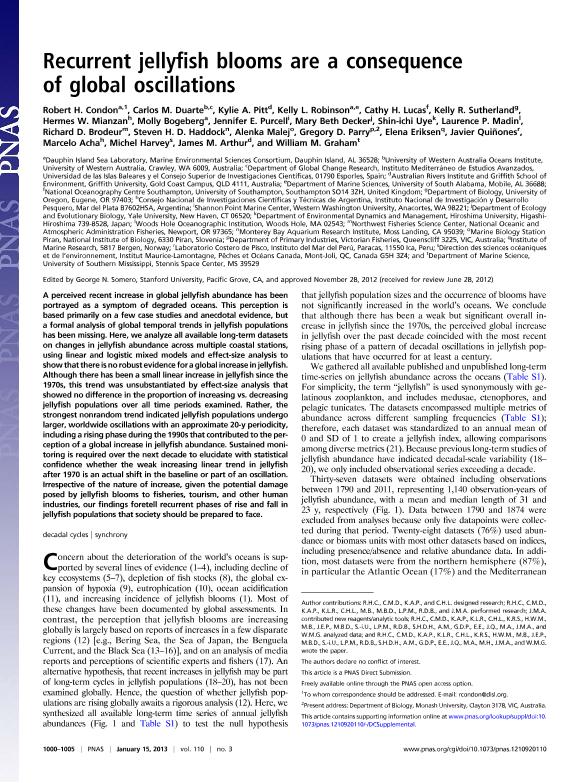Artículo
Recurrent jellyfish blooms are a consequence of global oscillations
Condon, Robert H.; Duarte, Carlos M.; Pitt, Kylie A.; Robinson, Kelly L.; Lucas, Cathy H.; Sutherland, Kelly R.; Mianzan, Hermes Walter ; Bogeberg, Molly; Purcell, Jennifer E.; Decker, Mary Beth; Uye, Shin-ichi; Madin, Laurence P.; Brodeur, Richard; Haddock, Steven H.D.; Malej, Alenka; Parry, Gregory D.; Eriksen, Elena; Quiñones, Javier; Acha, Milena; Harvey, Michel; Arthur, James M.; Graham, William M.
; Bogeberg, Molly; Purcell, Jennifer E.; Decker, Mary Beth; Uye, Shin-ichi; Madin, Laurence P.; Brodeur, Richard; Haddock, Steven H.D.; Malej, Alenka; Parry, Gregory D.; Eriksen, Elena; Quiñones, Javier; Acha, Milena; Harvey, Michel; Arthur, James M.; Graham, William M.
 ; Bogeberg, Molly; Purcell, Jennifer E.; Decker, Mary Beth; Uye, Shin-ichi; Madin, Laurence P.; Brodeur, Richard; Haddock, Steven H.D.; Malej, Alenka; Parry, Gregory D.; Eriksen, Elena; Quiñones, Javier; Acha, Milena; Harvey, Michel; Arthur, James M.; Graham, William M.
; Bogeberg, Molly; Purcell, Jennifer E.; Decker, Mary Beth; Uye, Shin-ichi; Madin, Laurence P.; Brodeur, Richard; Haddock, Steven H.D.; Malej, Alenka; Parry, Gregory D.; Eriksen, Elena; Quiñones, Javier; Acha, Milena; Harvey, Michel; Arthur, James M.; Graham, William M.
Fecha de publicación:
01/2013
Editorial:
National Academy of Sciences
Revista:
Proceedings of the National Academy of Sciences of The United States of America
ISSN:
0027-8424
Idioma:
Inglés
Tipo de recurso:
Artículo publicado
Clasificación temática:
Resumen
A perceived recent increase in global jellyfish abundance has been portrayed as a symptom of degraded oceans. This perception is based primarily on a few case studies and anecdotal evidence, but a formal analysis of global temporal trends in jellyfish populations has been missing. Here, we analyze all available long-term datasets on changes in jellyfish abundance across multiple coastal stations, using linear and logistic mixed models and effect-size analysis to showthat there is norobust evidence for a global increase in jellyfish. Although there has been a small linear increase in jellyfish since the 1970s, this trend was unsubstantiated by effect-size analysis that showed no difference in the proportion of increasing vs. decreasing jellyfish populations over all time periods examined. Rather, the strongest nonrandom trend indicated jellyfish populations undergo larger, worldwide oscillations with an approximate 20-y periodicity, including a rising phase during the 1990s that contributed to the perception of a global increase in jellyfish abundance. Sustained monitoring is required over the next decade to elucidate with statistical confidence whether theweak increasing linear trend in jellyfish after 1970 is an actual shift in the baseline or part of an oscillation. Irrespective of the nature of increase, given the potential damage posed by jellyfish blooms to fisheries, tourism, and other human industries, our findings foretell recurrent phases of rise and fall in jellyfish populations that society should be prepared to face.
Palabras clave:
Decadal Cycles
,
Synchrony
,
Jellyfish
,
Blooms
Archivos asociados
Licencia
Identificadores
Colecciones
Articulos(CCT - MAR DEL PLATA)
Articulos de CTRO.CIENTIFICO TECNOL.CONICET - MAR DEL PLATA
Articulos de CTRO.CIENTIFICO TECNOL.CONICET - MAR DEL PLATA
Articulos(IIMYC)
Articulos de INSTITUTO DE INVESTIGACIONES MARINAS Y COSTERAS
Articulos de INSTITUTO DE INVESTIGACIONES MARINAS Y COSTERAS
Citación
Condon, Robert H.; Duarte, Carlos M.; Pitt, Kylie A.; Robinson, Kelly L.; Lucas, Cathy H.; et al.; Recurrent jellyfish blooms are a consequence of global oscillations; National Academy of Sciences; Proceedings of the National Academy of Sciences of The United States of America; 110; 3; 1-2013; 1000-1005
Compartir
Altmétricas



